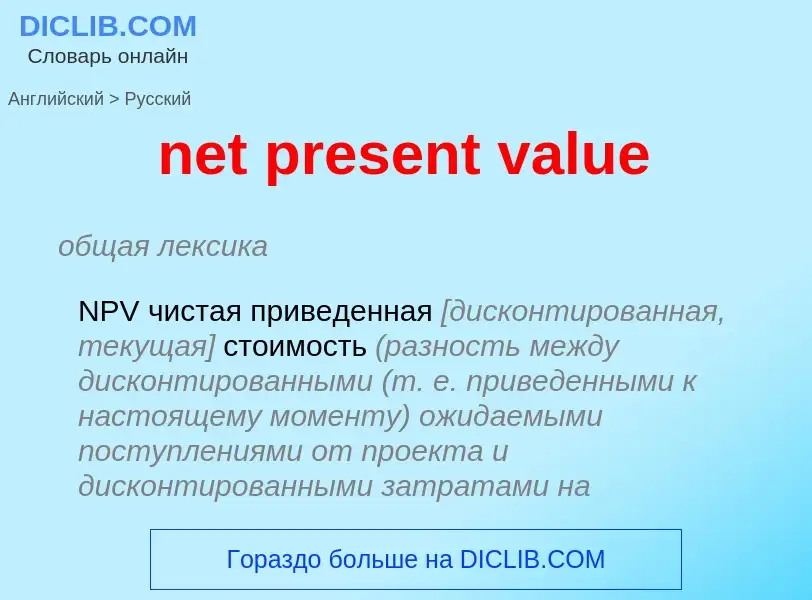Translation and analysis of words by ChatGPT artificial intelligence
On this page you can get a detailed analysis of a word or phrase, produced by the best artificial intelligence technology to date:
- how the word is used
- frequency of use
- it is used more often in oral or written speech
- word translation options
- usage examples (several phrases with translation)
- etymology
net present value - translation to russian
общая лексика
NPV чистая приведенная [дисконтированная, текущая] стоимость (разность между дисконтированными (т. е. приведенными к настоящему моменту) ожидаемыми поступлениями от проекта и дисконтированными затратами на осуществление проекта, включая величину первоначальных инвестиций)
Definition
Wikipedia
The net present value (NPV) or net present worth (NPW) applies to a series of cash flows occurring at different times. The present value of a cash flow depends on the interval of time between now and the cash flow. It also depends on the discount rate. NPV accounts for the time value of money. It provides a method for evaluating and comparing capital projects or financial products with cash flows spread over time, as in loans, investments, payouts from insurance contracts plus many other applications.
Time value of money dictates that time affects the value of cash flows. For example, a lender may offer 99 cents for the promise of receiving $1.00 a month from now, but the promise to receive that same dollar 20 years in the future would be worth much less today to that same person (lender), even if the payback in both cases was equally certain. This decrease in the current value of future cash flows is based on a chosen rate of return (or discount rate). If for example there exists a time series of identical cash flows, the cash flow in the present is the most valuable, with each future cash flow becoming less valuable than the previous cash flow. A cash flow today is more valuable than an identical cash flow in the future because a present flow can be invested immediately and begin earning returns, while a future flow cannot.
NPV is determined by calculating the costs (negative cash flows) and benefits (positive cash flows) for each period of an investment. After the cash flow for each period is calculated, the present value (PV) of each one is achieved by discounting its future value (see Formula) at a periodic rate of return (the rate of return dictated by the market). NPV is the sum of all the discounted future cash flows.
Because of its simplicity, NPV is a useful tool to determine whether a project or investment will result in a net profit or a loss. A positive NPV results in profit, while a negative NPV results in a loss. The NPV measures the excess or shortfall of cash flows, in present value terms, above the cost of funds. In a theoretical situation of unlimited capital budgeting, a company should pursue every investment with a positive NPV. However, in practical terms a company's capital constraints limit investments to projects with the highest NPV whose cost cash flows, or initial cash investment, do not exceed the company's capital. NPV is a central tool in discounted cash flow (DCF) analysis and is a standard method for using the time value of money to appraise long-term projects. It is widely used throughout economics, financial analysis, and financial accounting.
In the case when all future cash flows are positive, or incoming (such as the principal and coupon payment of a bond) the only outflow of cash is the purchase price, the NPV is simply the PV of future cash flows minus the purchase price (which is its own PV). NPV can be described as the "difference amount" between the sums of discounted cash inflows and cash outflows. It compares the present value of money today to the present value of money in the future, taking inflation and returns into account.
The NPV of a sequence of cash flows takes as input the cash flows and a discount rate or discount curve and outputs a present value, which is the current fair price. The converse process in discounted cash flow (DCF) analysis takes a sequence of cash flows and a price as input and as output the discount rate, or internal rate of return (IRR) which would yield the given price as NPV. This rate, called the yield, is widely used in bond trading.
Many computer-based spreadsheet programs have built-in formulae for PV and NPV.

